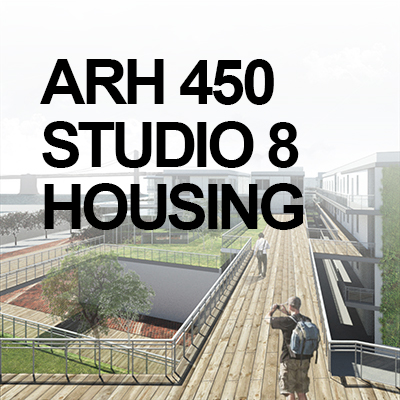
ARH 450 STUDIO 8 HOUSING AND INTEGRATED DESIGN
Housing is an essential function that architects provide. Collaborating as a team, you will design a multi-family housing complex for an urban site including an architectural proposal that integrates building systems and sustainable strategies. Plus, you’ll incorporate input from expert architects, engineers, and consultants. Take this course concurrently with ARH 440.
Prerequisite: ARH 320, ARH 330, ARH 350, ARH 399, ARH 430, ARH 440, & ARH 441 (ARH 440 & ARH 450 must be taken concurrently)
Course Learning Outcomes
- Develop a coherent design identity and document evidence-based decision-making processes used to incorporate feedback from Technical Advisors
- Analyze housing as a typology that has cultural and social implications through case study research
- Research the causes of housing shortage and design units for diverse households
- Develop and refine unit plans and aggregation strategies using clearly stated design and performance criteria
- Generate and interpret climate data visualizations for project site and use diagrams to visually explain the correlation to design parameters
- Compare different building massing and orientation options and their respective energy conservation levels using energy modeling tools
- Integrate envelope systems and assemblies using clearly stated design and performance criteria
- Integrate structural systems using clearly stated design and performance criteria
- Integrate environmental controls systems in the design of a building using clearly stated design and performance criteria
- Integrate life safety systems in the building design. Provide egress with two means of exit from all occupied floors, exit stairs separated by the required minimum distance, doors swinging in the direction of exit travel, and no dead-end corridors
- Provide an accessible path of travel from the sidewalk to all occupied areas in an equitable manner
- Document responsibilities of each team member and resolve conflicts in respectful and productive ways prioritizing project success
NAAB Criteria
- PC 6 Leadership and Collaboration How the program ensures that students understand approaches to leadership in multidisciplinary teams, diverse stakeholder constituents, and dynamic physical and social contexts, and learn how to apply effective collaboration skills to solve complex problems.and regulations as part of a project.
- SC 6 Building Integration (Ability) How the program ensures that students develop the ability to make design decisions within architectural projects while demonstrating integration of building envelope systems and assemblies, structural systems, environmental control systems, life safety systems,
and the measurable outcomes of building performance. *If taken concurrently with ARH 440 Environmental Controls - Shared Values: Leadership, Collaboration, and Community Engagement: Architects practice design as a collaborative, inclusive, creative, and empathetic enterprise with other disciplines, the communities we serve, and the clients for whom we work.
